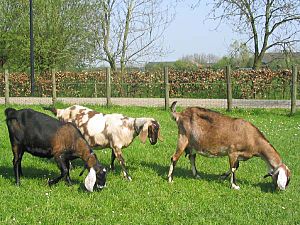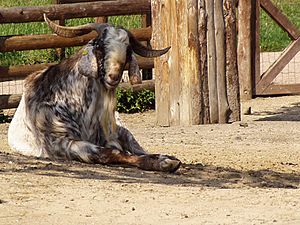Anglo-Nubian goat facts for kids
 |
|
| Conservation status |
|
|---|---|
| Other names | Nubian |
| Country of origin | United Kingdom |
| Distribution | more than sixty countries |
| Use | dual-purpose, meat and dairy |
| Traits | |
| Weight |
|
| Height |
|
|
|
The Anglo-Nubian is a special type of domestic goat from Britain. It first appeared in the 1800s. This breed was created by mixing British goats with large, floppy-eared goats from places like India, the Middle East, and North Africa.
Anglo-Nubian goats are easy to spot because of their long, hanging ears and a nose that curves outwards. They are very popular and can be found in over sixty countries around the world. In many places, people just call them the Nubian goat.
Contents
How the Anglo-Nubian Goat Began
The Anglo-Nubian goat breed started in the British Isles during the 1800s. It was developed by cross-breeding local British goats with a mix of large, floppy-eared goats. These imported goats came from India, the Middle East, and North Africa.
Many of these goats arrived in Britain on ships from the P & O Steamship Company. The ships often carried goats to provide fresh milk and meat during long journeys home from places like Asia. When the ships docked, some of these goats were sold. People often called them "Nubians," even if they came from different places. Some of these goats, especially the Egyptian Zaraibi breed, greatly influenced the Anglo-Nubian.
Three male goats, called billies, were very important in creating the breed. One was an Indian Jamnapari goat brought in 1896. Another was an Indian goat from Chitral District. The third was a Zaraibi goat, imported around the same time. The first Anglo-Nubian goats were officially recorded in 1910. After that, no more imported goats were used for breeding.
Some Anglo-Nubian goats were sent to the West Indies in the early 1900s. From there, some made their way to the United States, with the first ones arriving in 1909. Others were also sent to Brazil.
In 2017, the Anglo-Nubian was reported in over sixty countries worldwide. In 2007, the FAO said the breed was "not at risk" globally. This status was confirmed in 2020. However, in the United Kingdom, the breed was considered "endangered" in 2020.
What Anglo-Nubian Goats Look Like
The Anglo-Nubian is a large goat breed. They have long legs and a very distinct face with a nose that curves outwards. Their ears are long and hang down. Female goats, called nannies, have short, smooth coats. Male goats, or billies, have slightly rougher and longer coats.
These goats can come in many different colors. Their coats can be one solid color, or they can have patterns like stripes, swirls, or spots. Some common colors include white, cream, light brown, reddish-brown, and black.
What Anglo-Nubian Goats Are Used For
The Anglo-Nubian is a "dual-purpose" goat. This means they are raised for two main things: meat and milk. Young Anglo-Nubian goats, called kids, grow quickly, which makes them good for meat production.
While their milk production might not be as high as some other goat breeds, Anglo-Nubian milk is special. It has a higher percentage of fat, which makes it richer and creamier. Anglo-Nubian nannies usually produce about 3.9 kg of milk per day. This milk has an average fat content of about 4.8%. The most milk recorded from one goat in a single day was about 8.25 kg. The highest amount of milk recorded from one goat in a whole year was over 2500 kg!
Images for kids




